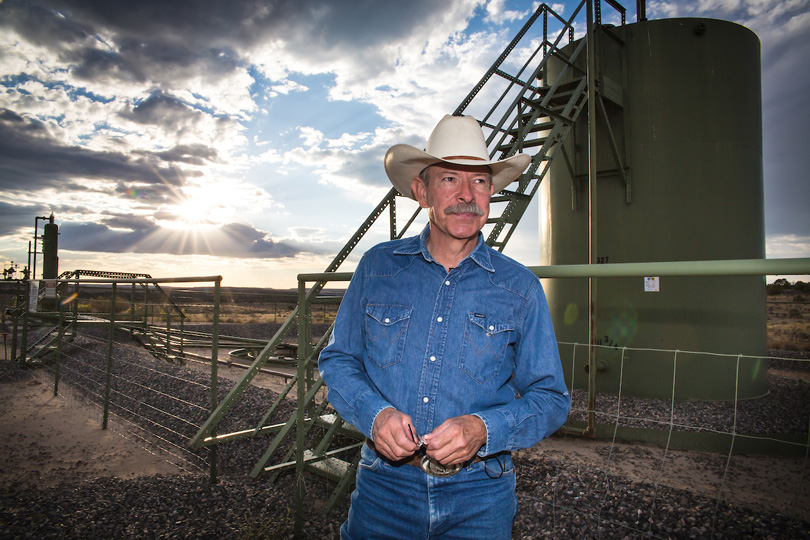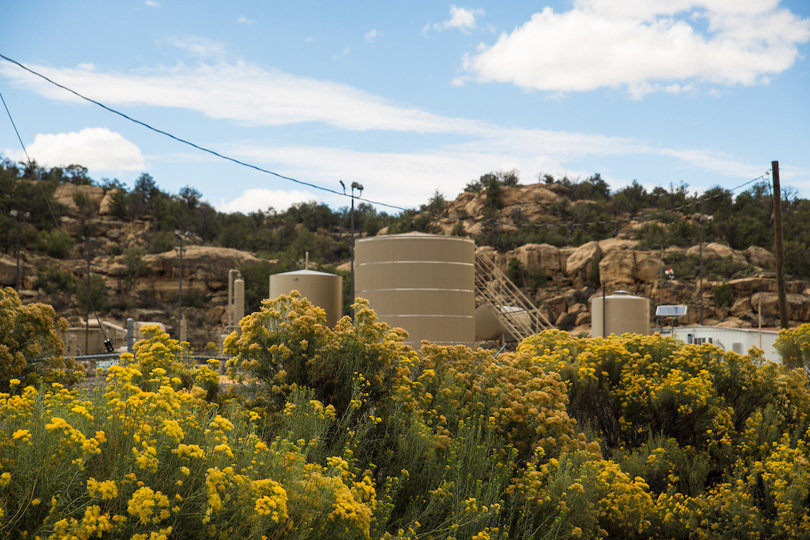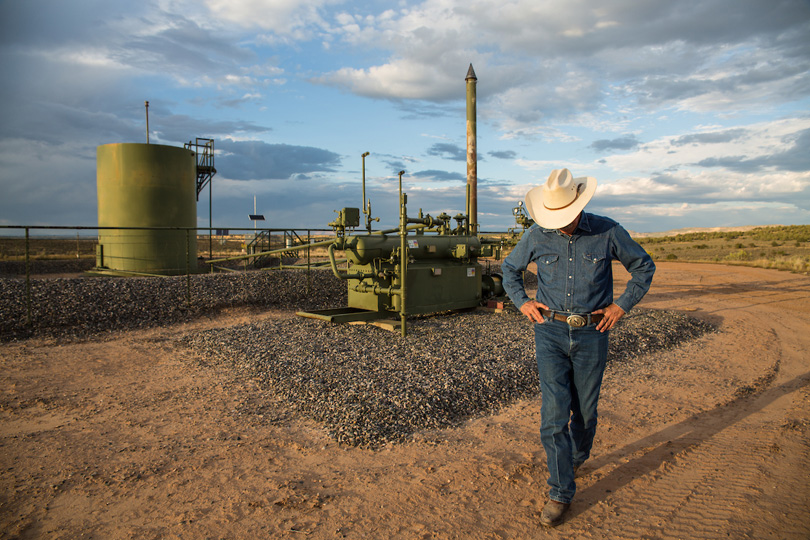Today, one of New Mexico’s largest oil and gas producers, Hilcorp Energy, dropped its recently filed request to increase the number of wells it can drill or frack in the San Juan Basin, already home to tens of thousands of gas wells. Hilcorp’s proposal also would have shut the public out of the decision-making process by establishing an “administrative approval” process.
Back in 2014, this corner of northern New Mexico made international headlines when NASA researchers discovered a persistent methane plume the size of Delaware. Two years later, they pinned one of the main sources of this methane “hot spot” to natural gas wells, pipelines, storage tanks, and processing plants in the San Juan Basin. A second peer-reviewed study last year confirmed those findings.
On Friday, state regulators were scheduled to hear Hilcorp’s request to amend the state’s well spacing regulations, which would have allowed the company to drill more wells or target different formations than the rules currently allow.
“The effect of that would be that rather than having a public hearing process where each of those items is heard, that entire process would be done away with and it would only require the local Oil Conservation Division official,” said Don Schreiber, a rancher who lives in the San Juan Basin and had opposed the rule change. “His name is Charlie Perrin and the oil company could just walk in and say ‘Charlie, we want to drill some wells or recomplete some wells and just sign right here.’”
(Well) Space Race
It’s a move that would have had big implications for the entire state’s drilling industry. If the state allowed Hilcorp an exception from the rules, it risked an outcry from other drillers if it later denied them the same. And the impacts in this remote corner of New Mexico could echo across the rest of the country — and, when it comes to climate change, the entire world.
The state now produces more oil than California or Oklahoma and ranks as the nation’s third largest oil-producing state after Texas and North Dakota, according to the New Mexico Oil and Gas Association. And, as NASA found, leaks here of methane, a powerful greenhouse gas, are unusually pronounced. In addition, in the rural Four Corners region where Utah, Colorado, New Mexico, and Arizona meet, smog levels reached so high last year that scientists warned the region is at risk of breaching national health standards.
The central issue of Hilcorp’s seemingly mundane request is enormously consequential, because it relates to one of the most clear-cut limits that drillers face: how densely they are allowed to drill their wells.
Currently in New Mexico, as in many states, drillers have to follow well spacing rules, which cap the number of wells targeting a given rock formation per “unit,” typically 640 acres.
That’s a vital control because it’s relatively simple for state officials to enforce, unlike many pollution controls which require periodic inspections or constant monitoring. Either the company is allowed to drill a new well or it isn’t.
Because the San Juan Basin is home to numerous oil- and gas-rich formations and the limits are per-formation, wells there are already densely packed.
“We have on and immediately around our area 122 wells, I think,” Schreiber said. “I can see 10 wells from my house. There’s more wells than that that may be shielded by a tree or a canyon. We’re very typical of the San Juan Basin — not picked on by the oil companies in any way.”
Parts of the San Juan Basin already look like a patchwork of wellpads and access roads when viewed from above, shown here in 2008. Credit: Doc Searls, CC BY–SA 2.0
‘Rip and Run’
Founded in 1998, Houston-based Hilcorp became one of America’s largest private oil and gas companies, thanks largely to a well-timed 2011 deal in Texas’ Eagle Ford shale.
It made its founder, Jeffrey Hildebrand, among America’s 150 wealthiest individuals, with a personal fortune valued at $4 billion by Forbes or $9.5 billion by Bloomberg, the Revelator reported last May.
Hilcorp sums up its business philosophy in three words: “acquire and exploit.” It has gained a reputation for buying up oil and gas fields that have fallen out of major oil firms’ focus and reinvigorating the fields, in part by slashing operating costs and fostering a rules-be-damned corporate culture.
There’s little question Hildebrand knows how to motivate workers — in 2015, Hilcorp went viral when it paid all of its employees a $100,000 bonus after the company hit its five year productivity targets. Other Hilcorp bonus incentives have included $50,000 vouchers for new cars or $35,000 cash.
But the company has also earned a reputation for an unusually high degree of recklessness, at times threatening the lives of those same workers and generating outrage from locals — and even from typically staid state environmental regulators over the company’s disregard for the harms it does to others.
Hilcorp’s track record in Alaska, where it has operated only since 2012, is riddled with spills, accidents, and intentional violations of state law.
In September 2015, three Hilcorp contractors in Alaska were nearly suffocated by a nitrogen leak — despite the fact that Hilcorp never got state permission for nitrogen use at that location — leading to a fine of $200,000. That accident was less than a year after four workers nearly died in a fire on an offshore operating platform.
Investigative reporting by Inside Climate News and the Revelator discovered that state regulators grew frustrated with Hilcorp to a highly unusual degree. “The disregard for regulatory compliance is endemic to Hilcorp’s approach to its Alaska operations and virtually assured the occurrence of this violation,” the chair of Alaska’s Alaska Oil and Gas Conservation Commission (AOGCC) wrote to the company in November 2015, Inside Climate News found. “Hilcorp’s conduct is inexcusable.”
“Hilcorp’s history of noncompliance and its failure to take the rudimentary measure of entering AOGCC‘s requirements in its regulatory tracking system preclude any claim that Hilcorp has acted in good faith,” said a 2016 state decision fining the company for failing to file required reports.
In Ohio, the oil and gas firm is suspected of causing over 75 earthquakes, due to fracking operations which inject fluids into shale formations to crack open and release the fossil fuels within them. Hilcorp’s Louisiana track record includes seven oil spills in just one year, totaling over 23,000 gallons of crude.
The feds fined Hilcorp for five Clean Air Act violations in Pennsylvania between 2014 and 2015. The following year, the U.S. Pipeline and Hazardous Materials Safety Administration discovered an array of safety violations, “including failure to inspect and test gas pipeline main valves and relief valves, failure to follow control-room management procedures and failure to accurately report pipeline flow data,” the Revelator reported.
“Every other company seems to get it but Hilcorp,” Scott Eustis, coastal wetland specialist for the Gulf Restoration Network, told the Revelator after Hilcorp leased up land used by oystermen after its illegal dredging methods damaged oyster beds. “They are a company whose business model is rip and run, and their acquisition of oyster leases is a plan to pollute.”
A drilling site in the San Juan basin near Devil Springs Ranch. Credit: Julie Dermansky ©2014
Last year, Hilcorp bought San Juan acreage from oil giant ConocoPhillips in a deal worth up to $3 billion ($300 million of the price is dependent on gas prices). Now, Hilcorp has made the San Juan Basin — where ConocoPhillips struggled with methane leaks that were triple the rate of the company’s operations in other parts of the U.S. — its major new focus. In addition to the ConocoPhillips deal, it bought up 300,000 acres from XTO Energy in December, bringing its total well count in the San Juan to over 15,700.
“Hilcorp sees decades of future production and development in the basin,” Greg Lalicker, president and chief operations officer, said in a statement after the acquisition. “We are excited for the opportunity to enhance oil and natural gas production in the Four Corners region, and we expect to become responsible members of the local community by boosting economic activity and developing strong, long-lasting partnerships.”
Drilling and the Devil Springs Ranch
For Schreiber, the prospect of changing well spacing rules was about a lot more than just paperwork, it’s about the ranch he calls home.
He and his wife retired in 1998 and moved out to the country. “For two years, we were busy building a ranch,” he told DeSmog. “We were deliriously happy, riding horses every day.” The couple began working to bring sustainable agriculture into the area while restoring the arid ecosystem that had been damaged by over-grazing.
“Drilling activity picked up and it just finally occurred to us, sitting on horseback trying to move a bunch of cows and watching them roll a D8 bulldozer off the back of a trailer and do an amount of damage in 15 minutes that we could spend a year trying to reverse,” Schreiber told DeSmog. “If we were intent on preserving it so that our grandkids could actually see a ranch, we couldn’t do it by raising grass, we had to do it by stopping that bulldozer.”
Oil and gas infrastructure on Don Schreiber’s ranch in Blanco, New Mexico. Credit: Julie Dermansky ©2015
Schreiber ticks off a list of what’s changed in his community due to oil and gas drilling — not just harm to wildlife but also to the town’s population. “Decades ago there were four churches and three schools in this area. We don’t have the little schoolhouses. Now my nearest neighbor is 10 miles away and there’s no schools, no churches,” he said. “Such a wonderful part of the world had just been given over to oil and gas.”
He’s already seen the impact of dense well spacing in the San Juan. “The spacing rules apply to each formation so that depending on how the state decides those formations can be developed. Those are cumulative on the surface,” he said. “So by the time this all gets to the surface of the ground, you have so many multiple spacings that are overlapping that you wind up with this — a pincushion, a spider web, a sacrifice zone.”
Nonetheless, Schreiber said, he’s been part of successful campaigns to limit the damage done.
“Each well location takes a road and takes a pipeline, so when they build one of these things, they’re gonna build a road and a pipeline,” he explained. “The amount of destruction just to get a very small road in this very rough country is tremendous. This is called a brittle environment — like an egg if you break it, you can’t repair it.”
“Our emphasis and our victory and what we achieved,” he added, “was to force oil companies to exhaust every option to drill from an existing well site before they were allowed to build a new location.”
Following reports that the New Mexico Attorney General’s office planned to become involved in this latest case, Hilcorp Energy dropped its request to evade the well spacing rules. As of publication time, neither Hilcorp nor Adam Rankin, an attorney representing Hilcorp, had responded to request for comment.
“The Office of the Attorney General is monitoring this issue and will always take appropriate action to ensure that government agencies and processes are transparent and open to the public,” said James Hallinan, communications director of the New Mexico Attorney General’s office.
For now, Schreiber says, the important thing is to remain vigilant.
“It’s an important victory today,” he told DeSmog, “but we know they’ll be back.”
Main image and above: Don Schreiber showing the oil and gas infrastructure in New Mexico’s San Juan Basin. Credit: Julie Dermansky ©2014
Subscribe to our newsletter
Stay up to date with DeSmog news and alerts










